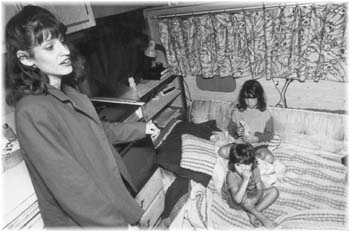![[MetroActive News&Issues]](/gifs/news468.gif)
![[MetroActive News&Issues]](/gifs/news468.gif)
[ Metro Santa Cruz | MetroActive Central | Archives ]
Back to Work
Working Mother-To-Be: Tammy Gilmore hopes to find a job that pays enough to allow her to move out of the small Zayante camper where she now lives with her daughters, Kendra, age 3, and Kaula, 6.
After 20 years of political squabbling, California lawmakers are crafting a welfare reform bill that could find jobs for a half-million people--but some folks are being left out of the new deal
By Eric Johnson
Harsh rhetoric has dominated the welfare discussion ever since Ronald Reagan launched the reform crusade almost 20 years ago. Shortly before leaving Sacramento for Washington, Reagan termed the welfare system "the worst economic mess since the Great Depression," and introduced the terms of debate which have persisted to this day. Railing against "welfare cheats," he decried welfare dependency and demanded personal responsibility.
Democrats responded by refusing to even concede that the issue was worth debating. While they acknowledged that the welfare system wasn't working, they attacked the new breed of Republicans as class-bigots engaged in a massive act of blaming-the-victims.
For two decades, the parties battled to an impasse. The words "welfare reform" were said in every single national political campaign, but nothing much was done.
The debate created an army of Reagan Republicans: working-class people who felt they were being ripped off by lazy poor people. It also had social repercussions, deepening racial and class divisions.
Then Bill Clinton came along. And then Newt Gingrich.
When the president signed the 1996 Personal Responsibility and Work Opportunity Reconciliation Act, he fulfilled Ronald Reagan's vision--forced to do so by the Army of Gingrich. Clinton even stole a line, standing in the Rose Garden and declaring "an end to welfare as we know it."
A New Job Description: County welfare agencies already have shifted their focus to provide education, job training and employment.
Plus, views from the inside of the System: a reluctant welfare mom, a lifelong welfare recipient and a welfare adult without kids.
Crystal Clear
TIM COMSTOCK, press liaison for Gov. Pete Wilson's health and welfare department, is trying his best to explain what's going on down the hall from his office. This involves some fancy crystal-ball-gazing, given that the issues around welfare reform are complex, all five reform bills are now dead, and the political winds seem to be shifting every day.
The governor is unavailable for comment, and the first-string spin doctors are tied up talking to the L.A. Times and potential swing-voting Republican lawmakers. When pressed, Comstock is willing to cough up some quotes. He knows the story about as well as anyone outside the small room where the Big Five--the governor and the leaders of both houses--have been locked in negotiation for the past week. He insists that the historic agreement taking shape will in fact work.
"It's not going to be easy," he concedes. "We're talking about a huge social change. But we've gotta have faith that in our society, if this is shown to be heartless, if people are getting screwed, then we'll do something to make it right."
During 15 minutes of conversation, the Wilson administration's press flack maintains his upbeat tone. Despite all the uncertainty, despite 20 years of partisan rancor--which isn't over yet--he is optimistic.
Of course, it's Comstock's job to be upbeat. What's startling is that everyone familiar with this issue, including liberal Democrats and advocates for the poor, have the same sound in their voices: hope.
The numerous press reports which depict a hard-hearted Wilson administration beating back a fervid Democrat-controlled Assembly are not entirely false. When the governor vetoed the bill which came out of a bi-partisan committee two weeks ago, he attacked Democrats for sending him a package of bills which "perpetuate a gravely flawed system that discourages work and encourages welfare dependency."
Apparently, he said, the package had been "crafted by the most overzealous of welfare-rights advocates."
In theory, the dispute remains deep and bitter. But it does not really take up that much legislative territory.
Dozens of interviews conducted over the past two weeks reveal that on most of the key questions, local representatives from both parties, as well as the Democratic and Republican leadership, are in agreement.
As this story goes to press, with the assembly entering the final week of work before summer break, there is reason to believe that California lawmakers may soon unlock a stalemate that has polarized and paralyzed the state for two decades.
Get a Job
SANDY BROWN of the Campaign for Budget Fairness, which advocates for low-income people, says the process that brought the Big Five together last week was a good one. "The negotiations produced a rational and realistic policy choice," Brown says.
But as the eleventh hour approached, she says, things began to get ugly: "After Pete Wilson's veto of the conference committee vote, the process was undermined. It was turned into a political game. Discussions became very partisan in nature."
Bruce McPherson, Santa Cruz's Republican senator, defends the governor's veto. But he breaks rank with the right wing of his party when discussing policy.
"I am concerned about some of my conservative colleagues who say people on welfare aren't worth a damn," McPherson says. "People sometimes get into situations which are not the fault of the individual or the family, where they need some help. I want to be able to provide that, and, by providing training, child care, and incentives, to encourage people to try and get a job."
Fred Keeley, Santa Cruz's Democratic assemblyman, predicts that when the Big Five get done wrangling with it, the welfare reform bill will look a lot like Assembly Bill 1501, the one the governor vetoed. "I bet we get 70 percent of what was in there," Keeley says.
Contemplating that possibility, Keeley imagines a profoundly favorable scenario.
"This could well mean a new era for our community," he says. "This could mean not only the end of welfare as we know it, but the end of poverty as we know it."
Poverty, in California, mostly affects single women with children. There are presently 478,000 people collecting Temporary Aid for Needy Families (the re-named Aid for Families with Dependent Children program), almost all of them single moms.
Federal law decrees that all of these women must find work in five years at most. That task seems daunting until the details come into focus--then it seems impossible. Many of these woman are not trained to perform the kind of work that would allow them to support their families. Even if they were, statistics show that in many California counties, including Santa Cruz, there are virtually no jobs available. And if there were, there are no child-care slots to accommodate all the kids.
Many welfare recipients also face mundane-yet-crippling barriers like lack of transportation, while some have substance abuse problems or suffer from mental illness.
If some version of AB 1501 survives the week, it will almost certainly contain funding to deal with many of those needs.
At press time, the bill on the table provides money to put 425,000 welfare recipients into the GAIN training program by 1999--that's 275,000 more than can take part in the program now. It creates 120,000 new child-care openings this year, and possibly another 100,000 next year. (The bill assumes, somehow, that the rest of the 230,000 kids living in families now on welfare will be able to stay with their grandparents or neighbors.) It also provides for substance abuse treatment, mental health counseling and help for victims of domestic violence.
All good, according to Sandy Brown. But meaningless, unless there is work available for these people.
"When you get down to it, this whole problem is really about job availability," Brown says. "The 'welfare-to-work' plan really has to be about creating jobs, because there aren't enough out there."
"When Republicans spend all their time talking about responsibility and incentives, and when the governor gets up there and accuses these people of being unwilling to work, that's insulting."
Party Animal: Governor Pete Wilson vetoed a Democratic reform bill two weeks back, saying it looked like it was 'crafted by the most overzealous of welfare reform advocates.'
Reagan Democrats
THE WELFARE-TO-WORK program is made up of 22 separate components. Many would cost nothing--for instance, one calls for retired CEOs to lobby business leaders to hire welfare recipients.
But four of the proposals involve public financing of jobs. The current bill contains an Investment Fund that would provide $25 million and an Infrastructure Bank that would provide another $50 million so counties could hire people to build bridges and staff libraries. There is another $40 million fund to send working Californians back to college so their entry-level jobs will become available, and a $5 million "micro-enterprise" fund to allow welfare recipients a shot at entrepreneurship.
But while those look like hard-core Democrat proposals along the lines of the New Deal and the Great Society, the most ambitious program contains a healthy dose of Reagan-era cooperation with big business. The $350 million Linked Deposit Fund shifts some of the state's deposits to private companies so they will hire and train aid recipients.
Keeley says this section of the proposed reform is crucial.
"In a good year in California, even in a rip-roaring economy like the one we're looking at now, the most we're ever going to see is 350,000 new jobs," he says.
"When we help folks get transitioned from welfare to work, we need to make sure they can stay there. Otherwise we haven't done anything for that person, their family or the community.
"That's why this job creation program is the centerpiece of this legislation."
McPherson is less excited about the program, although he isn't putting up too much of a fuss about it. Instead, to make certain it works, he wants to ensure that the work-requirement language in the bill is firm--the conference committee bill contains so many exemptions, it's difficult to imagine that anyone would ever really be forced to get a job.
"This would have left the state open to a huge expenditure--$500 million to a billion dollars," McPherson says, "and that means money taken away from education, health services and other programs."
Republican ideology also plays a role in shaping McPherson's opinions on the issue. "Let's face it," he says, "there are people who are depending on welfare for their standard of living." While he concedes that his district is way short of jobs for these people, he suggests that the citizens of Santa Cruz think about that when they consider "the conflict between the environment and the economy."
Even though he takes issue with some of the particulars, McPherson says he believes a compromise will be crafted out of the Democratic proposal. Again, this is partly thanks to his moderate- Republican fiscal sensitivity. If California doesn't put something together in the very near future, the state will lose $190 million of federal money.
Gov. Wilson faces that hard reality, and two Democratic houses--with a scant 34 percent approval rating. According to Keeley, that means California will probably get a welfare reform bill--perhaps even before this article goes to print.
"What President Clinton found out is that he didn't have an inexhaustible amount of political capital to continue vetoing welfare reform bills forever," Keeley says. "I don't think Pete Wilson wants to expend what political capital he has on this issue.
"I don't think he wants to be perceived as the impediment to welfare reform."
Copyright © Metro Publishing Inc. Maintained by Boulevards New Media.

Robert Scheer![[line]](/gifs/line.gif)
![[line]](/gifs/line.gif)

George Sakkestad
From the July 31-Aug. 6, 1997 issue of Metro Santa Cruz.